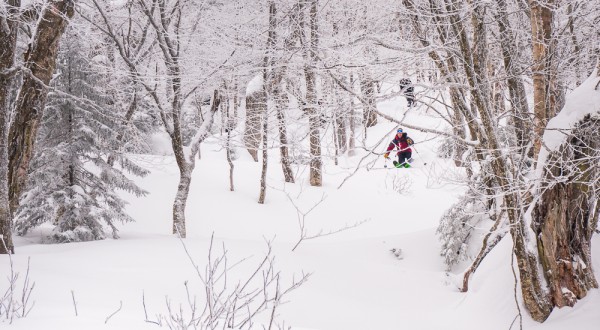
Most Vermonters are familiar with the Long Trail, a beautiful 272-mile hiking trail which spans the length of the state from Canada to Massachusetts. However, not everyone is aware of a similar trail designed for cross-country skiing. The Catamount Trail is 300-miles-long and features a variety of terrain including cross-country ski areas, farms, snowmobile trails and hilly backcountry terrain.
In contrast to the Long Trail which covers some of the highest terrain in the state, the Catamount Trail is at somewhat lower elevations, making it harder for organizers to acquire land and easements. Nevertheless, in 2008, after 24 years of putting together the pieces, the trail was completed. The Catamount Trail is divided into 31 sections, each with its own volunteer trail chief. The trail includes almost 200 parcels of private land and 135 acres of public land. It crosses or abuts 25 cross-country ski areas. To date, 46 skiers are “end-to-enders,” having completed the entire trail in one trip or several.
Two of those end-to-enders are Rich and Sheri Larsen of Essex, who also lead day tours for the Catamount Trail Association (CTA), the non-profit organization which maintains the trail. “When I retired,” said Sheri, “I decided I wanted to hike the length of the Long Trail and ski the full Catamount Trail. The Catamount Trail took longer because it’s a shorter season.”
The couple finished off the trail by taking part in week-long trips organized by the CTA. The organization used to have one week-long trip each year but now they have expanded to two; one for the southern section and one for the north so that just by taking part in the week-long tours, a skier can cover the state in the span of two years, weather and snow permitting.
Well before their retirement, the Larsens were skiing the Catamount Trail but confining their efforts to the northern part of the state, with emphasis on the section of the trail that reaches from the Bolton Valley Nordic Center to Trapp Family Lodge, known by those who ski it as Bolton-Trapp. The couple is officially in charge of maintaining this section and for the last two decades they have led day tours on their “home turf.” Rich doesn’t suggest folks start with Bolton-Trapp since it is considered one of the more difficult sections of the trail. He notes that the southern part of the state tends to be flatter, as are some of the sections in the Craftsbury area.
Sheri recommends that someone who is used to skiing groomed terrain at cross-country areas should start their journey on the Catamount Trail with a day tour. The advantage to being in a group is the leader knows the terrain and can provide assistance. Skiers can also enjoy the group camaraderie. Another advantage is that by skiing in a group, cars can be positioned at each end of the trail section, making it easier to go from Point A to Point B.
The CTA holds an annual backcountry clinic which introduces skiers to some of the equipment and techniques needed when venturing off groomed terrain. Rich noted that those new to backcountry skiing may have to upgrade their equipment to wider, more robust skis, stiffer boots and stronger bindings. Some sections, such as Bolton-Trapp are easier to do with climbing skins which attach to the bottom of skis for greater traction on the uphill. Both Larsens insist that age is not a factor. “There are people in their 80s still doing backcountry skiing,” Sheri said.
CTA Executive Director Jim Fredericks extols the group’s outings as perfect opportunities to introduce people of all ages to the trail. CTA hosts close to 50 tours each winter including several three-day and week-long outings. “You develop a sense of camaraderie in a group,” he said, noting that many skiers will go out for dinner or drinks afterwards and might develop friendships which allow them to head out on other excursions together. Fredericks touts the health benefits of the trail, as well, adding that “earning your miles” by skiing up a trail is healthier than lift service at alpine ski areas, not to mention less crowded. He has met many skiers who were afraid to venture away from either Nordic or Alpine ski areas but after a day on the trail were hooked. “Why didn’t I try this earlier?” is a constant refrain he hears.
“The great thing about the Catamount Trail,” said Rich “is you get to ski in different places. It’s steep in some areas, but has a gentle grade over old railroad beds in others. Every single inch across the length of the state has very different terrain.”
Sheri concurred, noting that in one section near the Craftsbury Touring Center, the trail goes across a lake, over a mountain and next to a llama farm. “You wouldn’t be able to get that variety without the trail,” she said.
Fredericks believes that with the combination of light rolling hills and steep terrain, there’s something for everyone. Although more accomplished skiers may swoop down the steep stuff while newcomers are more apt to snowplow with trepidation, they all end the day together. “The group separates,” he said, “but it comes back together like a rubber band.” Skiers tend to take breaks to admire the views, catch glimpses of wildlife or check out bear claw markings on a beech tree. “It’s a tour, not a race,” he said. “It’s meant to be enjoyable.”
“The Catamount Trail is great for all ages,” Fredericks added, “because there is a variety of terrain and a sense of adventure. You might have tough conditions where you’re breaking two feet of heavy snow or you might have sunshine and light powder. Either way, it’s a heavenly world.”
Information about the Catamount Trail is available at Catamounttrail.org.
 Related Articles & Free Subscription
Related Articles & Free Subscription
Autumn Is Ideal for Jasper Park Visit



Comment here